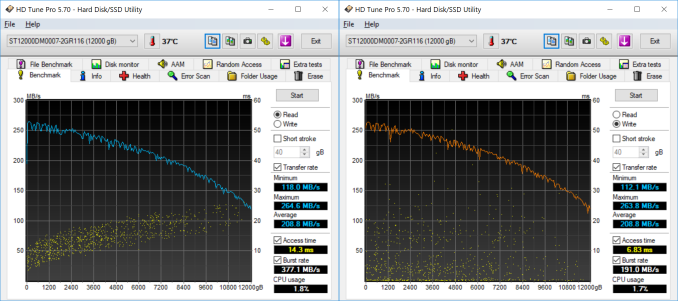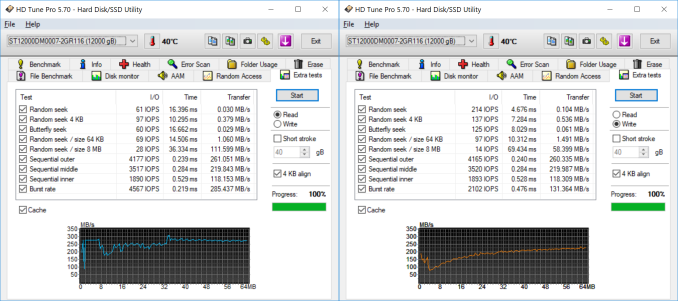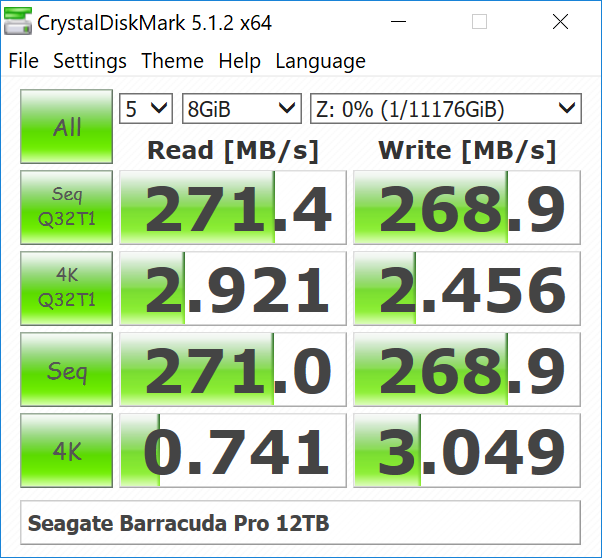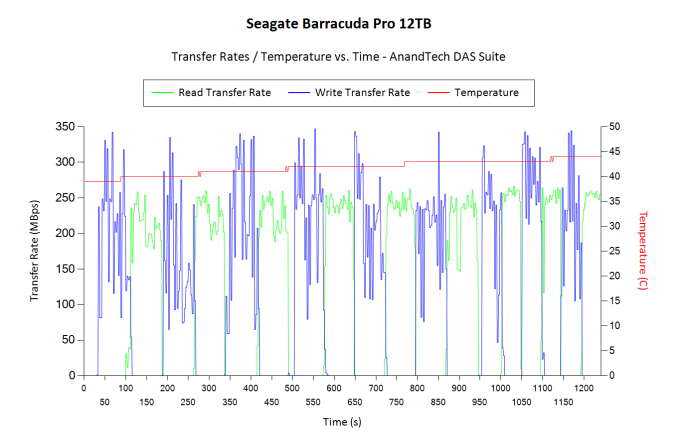Seagate BarraCuda Pro 12TB HDD Review
by Ganesh T S on November 15, 2017 8:00 AM EST- Posted in
- Storage
- Seagate
- HDDs
- Helium HDD
Performance - Internal Storage Mode
The performance of an internal storage device is dependent on the performance characteristics of the device as well as the file system being used. In order to isolate the effects of the latter, we first benchmarked the raw drives using HD Tune Pro 5.70. It was then formatted in NTFS and subject to our standard direct-attached benchmark suite.
Raw Drive Performance
HD Tune Pro allows us to run a variety of tests to determine transfer rates and IOPS for various artificial workloads. In addition, it also allows us to visualize how the performance varies as the tracking head moves from the outer parts of the platter towards the center (i.e, transfer rates as a function of the block address).
Empty drives are bound to perform very well, but, depending on the location of the data in the drive, we find that access rates can go as low as 112 MBps for sequential workloads. Write access times are a bit unpredictable due to the multi-segmented cache.
Random accesses are never the strong points of hard drives, and we see that the BarraCuda Pro delivers around 70 IOPS for 4K random reads and writes.
The extra tests help in putting some numbers to sequential accesses targeting different areas of the drive. It also provides some interesting numbers relevant to various random access workloads.
DAS Benchmarks
Consumers opting for drives such as the 12TB Seagate BarraCuda Pro typically need high-capacity local storage for holding and editing / processing large-sized multimedia files. Prior to taking a look at the real-life benchmarks, we first check what CrystalDiskMark has to report for the drive.
In order to tackle the real-life use-case of transferring large amounts of data back and forth from the drive, we created three test folders with the following characteristics:
- Photos: 15.6 GB collection of 4320 photos (RAW as well as JPEGs) in 61 sub-folders
- Videos: 16.1 GB collection of 244 videos (MP4 as well as MOVs) in 6 sub-folders
- BR: 10.7 GB Blu-ray folder structure of the IDT Benchmark Blu-ray (the same that we use in our robocopy tests for NAS systems)
| Seagate BarraCuda Pro 12TB robocopy Benchmarks (MBps) | ||
| Write Bandwidth | Read Bandwidth | |
| Photos | 219.23 | 205.51 |
| Videos | 231.42 | 219.46 |
| Blu-ray Folder | 234.05 | 230.02 |
These numbers are consistently around 15 - 20 MBps more than what we obtained for the 10TB drives last year.
While processing our DAS suite, we also recorded the instantaneous transfer rates and temperature of the drive. Compared to typical disk drives, the write transfers show higher instantaneous speeds due to a combination of the firmware and the 256 MB cache inside the drive. However, sustained write rates are comparable to other high-capacity drives when the cache is exhausted. The temperature of the unit at the end of the transfers (more than 250GB of traffic) rose by less than 5C, pointing to the power-efficiency of the platform.
For the use-case involving editing of multimedia files directly off the disk, we take advantage of PCMark 8's storage benchmark. The storage workload is a good example of a user workload, involving games as well as multimedia editing applications. The command line version allows us to cherry-pick storage traces to run on a target drive. We chose the following traces.
- Adobe Photoshop (Light)
- Adobe Photoshop (Heavy)
- Adobe After Effects
- Adobe Illustrator
Usually, PCMark 8 reports time to complete the trace, but the detailed log report has the read and write bandwidth figures which we present in our performance graphs. Note that the bandwidth number reported in the results don't involve idle time compression. Results might appear low, but that is part of the workload characteristic.
| Seagate BarraCuda Pro 12TB PCMark8 Storage Benchmarks (MBps) | ||
| Write Bandwidth | Read Bandwidth | |
| Adobe Photoshop (Light) | 250.22 | 9.06 |
| Adobe Photoshop (Heavy) | 246.88 | 11.48 |
| Adobe After Effects | 89.74 | 8.85 |
| Adobe Illustrator | 196.38 | 8.42 |
Compared to the results from the 10TB drive last year, we find that the read workloads are slightly worse off, but, the write workloads are much faster.















62 Comments
View All Comments
HStewart - Thursday, November 16, 2017 - link
Large amount of storage can be used for storage of logs and such especially when you have multiple locations. Of course you could have backupjameskatt - Sunday, November 19, 2017 - link
That is why you get three backups and an online backup.Arbie - Wednesday, November 15, 2017 - link
[Sorry, my question was for Ganesh, not the troll thread]I suppose it can be sussed out of the performance data, but... can you please say if this drive is shingle technology or not? With any Seagate drive that's one of my first questions, and they seem to have stopped identifying it in the literature.
ganeshts - Wednesday, November 15, 2017 - link
Oh, I covered that in the launch article, which is linked in the first paragraph.These are standard PMR drives, helium-ones with 8 platters.
XZerg - Wednesday, November 15, 2017 - link
I would suggest to include whether the drive is PMR, Shingled, ... storage in the table as both technologies co-exist but have different purpose/performance.Taracta - Wednesday, November 15, 2017 - link
Hello, the HD Tune random access are both Read not Read and Write. Please correct. Thank you.ganeshts - Wednesday, November 15, 2017 - link
My apologies! It has been fixed now.takeshi7 - Wednesday, November 15, 2017 - link
I really can't stand when people ask if a drive is SMR or "PMR". Every modern hard drive is PMR regardless of whether they are shingled or not. The proper term for a non-SMR drive is CMR.SMR - Shingled Magnetic Recording
CMR - Conventional Magnetic Recording
ganeshts - Wednesday, November 15, 2017 - link
That is a peeve I wouldn't object to, but, let us be honest - everyone treats SMR as the 'evolutionary update' to traditional PMR (CMR) drives. But, I appreciate this insight and will probably use it myself in future articles :)phoenix_rizzen - Wednesday, November 15, 2017 - link
To be pedantic, wouldn't SPMR and CPMR be more accurate?Shingled Perpendicular Magnetic Recording
Conventional Perpendicular Magnetic Recording